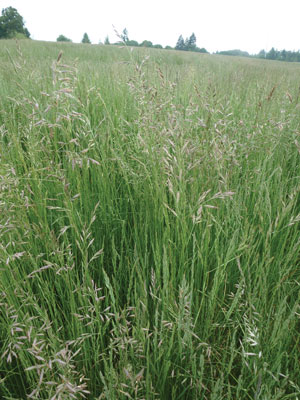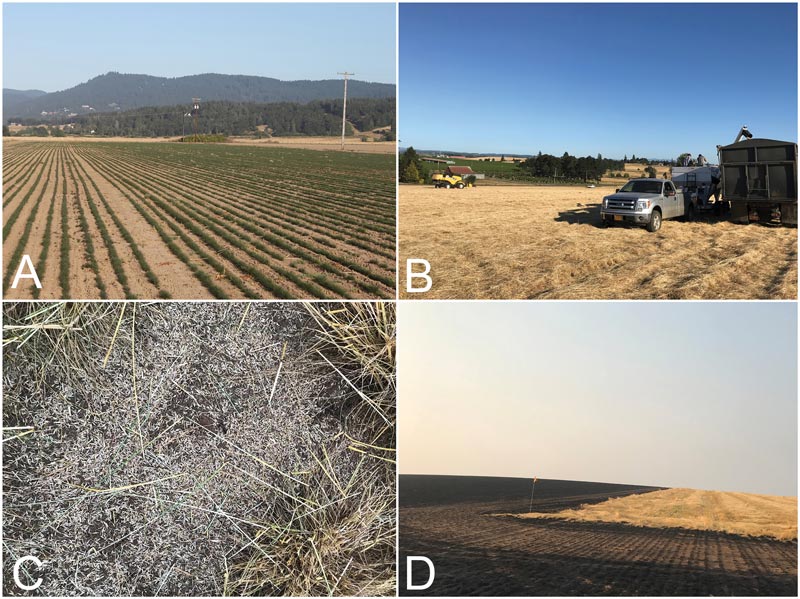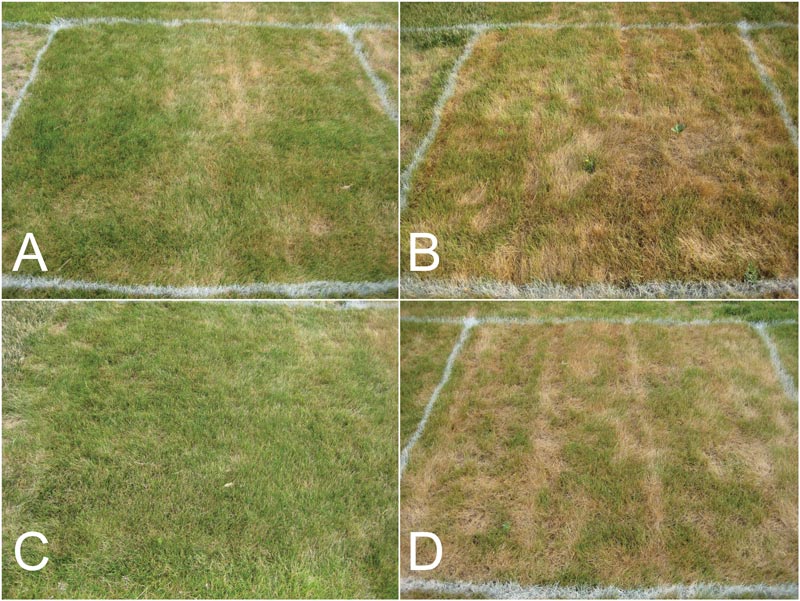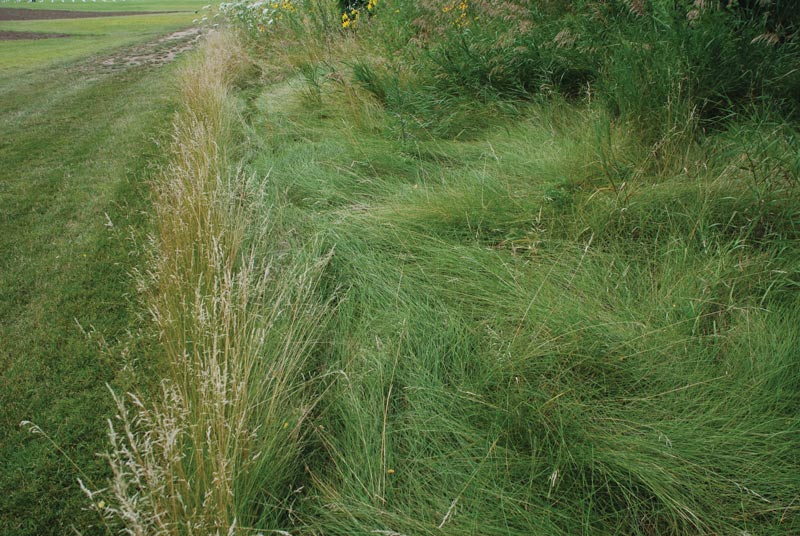
Right: Figure 1. A Chewings fescue seed production field. Photo by Leah Brilman
Five fine fescue grasses are commonly used in turfgrass systems: strong creeping red fescue (Festuca rubra subspecies rubra), slender creeping red fescue (Festuca rubra subspecies littoralis), Chewings fescue (Festuca rubra subspecies commutata), sheep fescue (Festuca ovina) and hard fescue (Festuca brevipila) (Table 1). These grasses are of interest because of their low-input (nitrogen fertilizer, irrigation and pesticide) requirements and slow-growth characteristics. In this article, we will discuss availability challenges (seed and sod production), establishment, fertility and mowing practices of fine fescues.
Editor’s note: This article is the second in a series about fine fescues on golf courses. Read the first installment, Classifying fine fescues used on golf courses, for clarified taxonomic classification of the five fine fescues common in turf systems.
Fine fescue seed and sod production
Since the 1930s and 1940s, the fine fescue seed production industry has grown in the United States, especially in the Pacific Northwest and particularly in Oregon, where roughly 60% of fine fescue seed production occurs in the foothills of the Cascade mountain range, and 30% occurs in the Grande Ronde Valley and Columbia River basin (5) (Figures 1, 2). Other major fine fescue seed production countries are Canada, Denmark and England.

Figure 2. Fine fescue seed production in the United States: (A) seedling rows of Chewings fescue; (B) seed harvest; (C) seed loss on the soil during harvest; and (D) field burning after harvest. Photos by Nicole Anderson
To increase seed yield quantity and quality, researchers have focused on harvest methods, residue management, lodging reduction and weed control (5). Improved technology and production practices have increased fine fescue seed yield by more than 200% in the past 33 years, but a persistent problem is fluctuation of annual seed yield (3) caused by stand age, residue management, fertility, pest control, environmental conditions and other factors.
Today, one of the biggest challenges of seed production is bans or limitations on open-field burning (Figure 2D), which is an effective way to deal with post-harvest residue and has been shown to reduce future pest problems, increase seed yields and increase profitability (5). Air pollution and safety issues associated with field burning have led seed production researchers to investigate alternative residue-management practices, such as nitrogen fertility, plant growth regulators, mowing and other non-thermal removal methods, such as full straw removal (5). The combination of seed production challenges and year-to-year fluctuation in seed yield is generally reflected in continually changing prices and seed availability.
Breeding efforts of the past 40 years have produced new cultivars with improved adaptation and tolerance to many environmental and management practices (3). These newer cultivars will improve a turfgrass sward with higher turf quality and density, greater stress tolerance, lower nutrient and water requirements, and fewer pest problems compared with older, less-improved cultivars (5) (Figure 3, below). These cultivars are not, however, always readily available to end users.

Figure 3. Comparison of new vs. old fine fescue cultivars on July 16, 2019, managed under minimal nitrogen fertilization, pest control and no supplemental irrigation in West Lafayette, Ind. (A) An improved Chewings fescue cultivar released within the past 10 years vs. (B) an old Chewings fescue cultivar released in the early 1990s; and (C) an improved strong creeping red fescue cultivar released within the past 10 years vs. (D) an old strong creeping red fescue cultivar released in the 1960s. Photos by Ross Braun
Table 1 shows the likelihood of finding each fine fescue taxa in retail seed mixtures in the northern U.S. Almost 70% of the fine fescue cultivars included in commercial lawn seed products in 2018 were released before 2009, which is a disadvantage to end users (5) (Figure 3). However, the likelihood of new and improved cultivars being included in professional marketed products may increase. When fine fescues were included in 2018 lawn seed products, they were typically 15% of the product weight, possibly because of the seed production issues mentioned previously, and because of fine fescues’ shorter shelf life when compared with Kentucky bluegrass (Poa pratensis) or tall fescue (Festuca arundinacea) (5).
Another approach to improving fine fescue availability is to increase sod production. Currently, only 10 growers in the U.S. produce fine fescue sod. Researchers from Purdue University and the University of Minnesota are conducting low-input sod research as part of the project “Filling a Critical Need: Diversifying Sod Production with Sustainable Turfgrasses” from the USDA Agricultural Marketing Service through the Specialty Crop Block Research Initiative Multi-State Program.

Figure 4. Fine fescue sod establishment may be a better option than seeding for sloped or other areas on the golf course that need fast and reliable establishment, such as bunker faces (pictured) and rough areas. Photo by Leah Brilman
Preliminary results with fine fescue sod production are promising, especially with strong creeping red fescue. Researchers are investigating sod strength, handling, shelf life, turfgrass species mixture compositions, sod maturation time, nitrogen fertility, and seeding rates to identify agronomic solutions to overcome sod production challenges and buyer preferences. Our goal is to assist and educate sod producers and buyers and thus create more opportunities for using sod (instead of seeding) for fast and reliable establishment of fine fescue on areas such as bunker faces and roughs (Figure 4).
Fine fescue establishment
Establishment vigor — the time required for seed germination and emergence and initial growth rate — affects competitiveness with other germinating grasses and/or weeds (11) (Table 1). Overall, fine fescues have intermediate germination and establishment rates compared with other turfgrass species (5).
Typically, strong creeping red fescue, Chewings fescue and slender creeping red fescue germinate and emerge faster than Kentucky bluegrass, slower than perennial ryegrass (Lolium perenne), and at a rate similar to tall fescue (5). Sheep fescue and hard fescue have less establishment vigor (that is, slower establishment) than the other three fine fescue taxa (Table 1). These differences among the five fine fescue taxa are due to several factors, such as germination and emergence rate, seed size, growth rate, growth habit, and efficiency of nitrogen use.
Fine fescues generally require five to 12 days after seeding to germinate, with sheep fescue and hard fescue near the top end of that range (5) (Figure 5, below). Fine fescues, especially Chewings fescue, also have a faster germination rate than bentgrasses (Agrostis species) at cooler temperatures. The optimal seed zone (soil) temperature for fine fescues has been reported to be 59 F (15 C). Further research is required to determine optimal seeding timings of the year for fine fescues in various cool-season climate zones, so, as part of the USDA-NIFA grant, researchers at Purdue, Minnesota, Oregon State and Rutgers are investigating how seeding date (monthly from March through November) affects establishment success.
Differences in growth habit (Table 1) influence establishment vigor. Hard fescue and sheep fescue have a bunch-type, non-rhizomatous growth habit, while strong creeping red fescue and slender creeping red fescue produce well-developed rhizomes, with the former having longer, robust rhizomes (12). Chewings fescue typically has a bunch-type growth habit, and, rarely, it can have few or very short rhizomes (12).

Figure 5. A mixture of strong creeping red fescue, slender creeping red fescue, Chewings fescue and hard fescue seedlings at six days after seeding on June 14 in West Lafayette, Ind. Photo by Ross Braun
Seeding rate can also influence establishment vigor. Seeding rate recommendations are typically given for the entire group of five grasses, but clear differences in seed size, both between taxa and within individual fine fescues, make generalized seed recommendations problematic (5).
For example, strong creeping red fescue, slender creeping red fescue and Chewings fescue typically have a larger seed size (282,000 to 564,000 seeds/pound) compared with hard fescue (334,000 to 590,000 seeds/pound) and sheep fescue (549,000 to 776,433 seeds/pound) (5). Seed size also varies between cultivars within a fine fescue taxon. These seed sizes correspond to typical lawn seeding rates ranging from 3.5 to 6 pounds/1,000 square feet for the fine fescues. Fine fescue seeding rates for golf course native (natural) rough areas are generally lower, ranging from 0.5 to 5 pounds/1,000 square feet, but these recommendations vary depending on seed size, cultivars, fine fescue taxa and the desired density of the final turfgrass sward (5). Additional research is required on seed size, seeding rate and seed germination characteristics of fine fescues to increase the likelihood of success on golf courses.
Fertilizing fine fescue
Applying phosphorus or increasing phosphorus levels has little to no effect on fine fescue germination and establishment rates, suggesting that fine fescues may require less soil phosphorus for establishment than other turfgrass species (5, 8).
Overall, fine fescues are able to maintain acceptable turf quality and better resist weed invasion when maintained at low to moderate nitrogen fertilization levels (1 to 2 pounds nitrogen/1,000 square feet) (5). Fine fescues also show differences in nitrogen use efficiency (4) (Table 1), with hard fescue > strong creeping red fescue > Chewings fescue > slender creeping red fescue. This may help explain why hard fescue persists on poor, infertile soils. Fully established fine fescues showed a minimal response in turf quality from increasing nitrogen fertilizer levels (4) and should not receive the same nitrogen levels as other turfgrass species. Excessive nitrogen will often lead to minimal to no improvement and may decrease overall turf quality and health. Long-term performance could be improved by increasing nitrogen fertilization during establishment to promote faster growth and then reducing nitrogen fertilizer over the longer term. Researchers working with the USDA-NIFA grant in three U.S. locations (Purdue, Minnesota and Oregon State) are investigating this possibility.
Fine fescue mowing heights
All five fine fescues are adaptable to a wide range of mowing heights, from 0.2 inch to unmowed. However, in cooler climates of North America and Europe, slender creeping red fescue, Chewings fescue and strong creeping red fescue better tolerate lower putting green mowing heights (0.125 to 0.25 inch; 3.175 to 6.35 millimeters) than do hard fescue and sheep fescue (5) (Table 1). This adaptation to close mowing is a key reason creeping red fescues and Chewings fescue have a long history of use on putting greens in Europe. Breeding efforts over the past 40 years have produced new cultivars of all five fine fescue taxa that are better able to persist at low mowing heights (3).
Today, Chewings fescue and slender creeping red fescue are the most commonly recommended for use in European golf course greens because of their close mowing tolerance and excellent winter hardiness and disease resistance (1, 2). Optimal mowing heights for Scandinavian putting greens are 0.20 to 0.24 inch (5.08 to 6.07 millimeters) for pure stands of Festuca rubra subspecies (Chewings fescue + slender creeping red fescue) and 0.16 to 0.20 inch (4.06 to 5.08 millimeters) for mixtures of Festuca rubra subspecies and colonial bentgrass (Agrostis capillaris) (6). These are slightly higher than typical mowing heights of 0.10 to 0.19 inch (2.54 to 4.82 millimeters) on creeping bentgrass (Agrostis stolonifera) greens in the U.S., which may be one factor that has limited fine fescue use on U.S. greens. Another limiting factor is likely the encroachment of annual bluegrass in fine fescue greens, which will be discussed in more detail in the fourth article of this series.
Regardless, fine fescues have been shown to produce acceptable turf quality and to have green speeds similar to or faster than those of creeping bentgrass when mowed at 0.25 inch (6.35 millimeters) (10). Therefore, if future regulations require reduced inputs on greens in the north-central U.S., then Chewings fescue would be a viable option (10). In the U.S., Chewings fescue is used in emergency situations requiring temporary seeding to repair damaged greens or fairways because it establishes faster and is less aggressive than creeping bentgrass, and has similar close mowing tolerance (5).
All five fine fescues — in monocultures or mixtures — have produced acceptable fairway turf at mowing heights of 0.5 to 1.0 inch (1.27 to 2.54 centimeters) under a variety of environmental conditions in the Northeast, North-Central and Pacific Northwest regions of the U.S., and in the United Kingdom, Scandinavia and Japan (5). However, fine fescues in low-maintenance fairways in cool-season climate zones can be challenged by traffic/wear tolerance, especially during periods of extensive drought, heat or disease stress. Fine fescue taxa, however, show different levels of disease resistance and traffic/wear tolerance (5). These issues will be discussed in more detail in the third and fourth installments of this series.
Because fine fescues tolerate a wide range of mowing heights, they are versatile and can be used in a variety of golf course situations, including putting greens, tees, fairways, roughs, and minimally mowed to no-mow rough areas (5).
In native rough areas on the golf course that are not mowed or are mowed infrequently, stem lodging (that is, the bending over of the grass stems) can decrease aesthetics and playability (7, 9) (Figure 6, below). However, fine fescues have been reported to differ in their ability to resist lodging (7, 9) (Table 1), and further research is required on seeding rates, establishment, pest control and stem lodging in fine fescue in minimal-mow to no-mow native rough areas.

Figure 6. Lodging in a fine fescue natural golf course rough area (on the right). Photo by Aaron Patton
Lastly, fine fescues have a slower vertical growth rate than other turfgrass species, such as tall fescue and perennial ryegrass, but faster growth rates than some bentgrasses at putting green heights (5). A slower vertical growth rate reduces mowing requirements. However, additional research is required to validate and compare the growth rates, mowing requirements and performance of fine fescues with other turf species at various mowing height regimes. Researchers on the USDA-NIFA grant are conducting a multi-year experiment to quantify the mowing requirement and seasonal growth differences between fine fescue taxa and other cool-season turfgrass species.
Fine fescues in upcoming issues of GCM
Information about differences in abiotic stress tolerance of fine fescues will be published in the August 2020 issue of GCM, and common biotic pests (weeds, diseases and insects) of fine fescues and their management will be discussed in the September issue. See our blog and follow us on Twitter and Facebook.
Funding
This work was funded by the National Institute of Food and Agriculture, U.S. Department of Agriculture, Specialty Crop Research Initiative (2017-51181-27222), and by the Agricultural Marketing Service, U.S. Department of Agriculture, Specialty Crop Block Grant Program (A337-19-SCMP-18-001). The full manuscript is open-access and is available in Crop Science (https://doi.org/10.1002/csc2.20122).
The research says ...
- Fine fescue seed production fluctuates from year to year depending on the age of the grass stand, post-harvest residue management practices, soil fertility, pest control, environmental conditions and other factors.
- Further research is required on the effects of cultivar selection, establishment and management practices on fine fescue sod production.
- Fine fescues have intermediate germination and establishment rates compared with other turfgrass species.
- Overall, fine fescues are versatile because they provide acceptable turf quality when maintained at low to moderate nitrogen fertilization levels, and they tolerate a wide range of mowing heights, from 0.2 inch to unmowed.
Literature cited
- Aamlid, T.S., and B. Molteberg. 2011. Turfgrass species and varieties for Scandinavian golf greens. Acta Agriculturae Scandinavica, Section B 61:143-152 (https://doi.org/10.1080/09064711003645336).
- Aamlid, T.S., G. Thorvaldsson, F. Enger and T. Pettersen. 2012. Turfgrass species and varieties for integrated pest management of Scandinavian putting greens. Acta Agriculturae Scandinavica, Section B 62:10-23 (https://doi.org/10.1080/09064710.2012.677854).
- Bonos, S.A., and D.R. Huff. 2013. Cool-season grasses: biology and breeding. Pages 591-660. In: J.C. Stier, B.P. Horgan and S.A. Bonos, editors. Turfgrass: Biology, use, and management. Agronomy Monographs 56. ASA, CSSA, SSSA, Madison, Wis. (https://doi.org/10.2134/agronmonogr56.c17).
- Bourgoin, B. 1997. Variability of fine-leaved fescues (Festuca spp.) grown at low nitrogen levels. International Turfgrass Society Research Journal 8:611-620.
- Braun, R.C., A.J. Patton, E. Watkins, P. Koch, N.P. Anderson, S.A. Bonos and L.A. Brilman. 2020. Fine fescues: A review of the species, their improvement, production, establishment, and management. Crop Science 2020:1-46 (https://doi.org/10.1002/csc2.20122).
- Calvache, S., T. Espevig, T.E. Andersen, E.J. Joner, A. Kvalbein, T. Pettersen and T.S. Aamlid. 2017. Nitrogen, phosphorus, mowing height, and arbuscular mycorrhiza effects on red fescue and mixed fescue-bentgrass putting greens. Crop Science 57:537-549 (https://doi.org/10.2135/cropsci2016.04.0240).
- Cavanaugh, M., E. Watkins, B. Horgan and M. Meyer. 2011. Conversion of Kentucky bluegrass rough to no-mow, low-input grasses. Applied Turfgrass Science 8(1):1-15 (https://doi.org/10.1094/ATS-2011-0926-02-RS).
- Chang, Z., X. Jin and D. Li. 2014. Phosphorus responses vary among cool-season turfgrasses during establishment from seed. Agronomy Journal 106:1975-1980 (https://doi.org/10.2134/agronj14.0225).
- Hollman, A., E. Watkins and G. Heineck. 2018. The effect of fine fescue species and seeding rate in no-mow areas. Poster 1220. ASA & CSSA International Annual Meeting, Baltimore. (https://scisoc.confex.com/scisoc/2018am/meetingapp.cgi/Paper/113724).
- Horgan, B.P., E. Watkins and A. Hollman. 2012. Alternative grass species for use on low-input putting greens. 3rd European Turfgrass Society Conference, June 24-26, 2012, Kristiansand, Norway.
- Ross, M.A., and J.L. Harper. 1972. Occupation of biological space during seedling establishment. Journal of Ecology 60:77-88 (https://doi.org/10.2307/2258041).
- Stace, C.A. 2019. New flora of the British Isles. 4th edition. C & M Floristics, Middlewood Green, Suffolk, U.K.
Ross C. Braun is a lead research scholar, and Aaron J. Patton is interim department head and a professor in the Department of Horticulture and Landscape Architecture at Purdue University, West Lafayette, Ind. Eric Watkins is a professor in the Department of Horticultural Science at the University of Minnesota, St. Paul, Minn. Paul L. Koch is an assistant professor in the Department of Plant Pathology at the University of Wisconsin, Madison, Wis. Nicole P. Anderson is a field crops Extension agent in the Department of Crop and Soil Science at Oregon State University, Corvallis, Ore. Stacy A. Bonos is a professor in the Department of Plant Biology and Pathology at Rutgers University, New Brunswick, N.J. Leah A. Brilman is the director of product management and technical services at DLF Pickseed USA, Halsey, Ore.